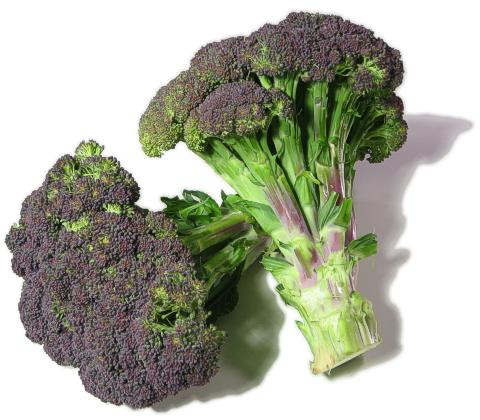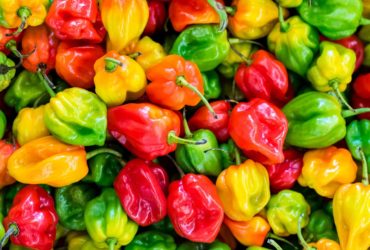BY: NORA IDRINA
When you think of broccoli, the first image that comes to mind is a miniature green tree. But did you know that there are also mini purple trees? The reason we don’t see purplish broccoli in grocery stores or in restaurants is because it tends to end up in landfills as food waste. When food doesn’t look right, it becomes trash. It doesn’t matter if it’s safe to eat, “ugly” produce typically goes to waste and is one of the major contributors to overall food waste among other causes that occur throughout the entire food chain.
We all know the gist of how food is grown and how it gets to us in grocery stores but how much do we know about what happens behind the scenes? And do we know how much of that contributes to food loss and waste? To what extent do our habits as consumers have an effect on waste? Let’s take a closer look starting from how food is produced, to how it is lost at each step in the food supply chain from the beginning of production down to when we, as consumers, buy the food and bring it home.
A snapshot of how food is produced
Food production is a long and labor-intensive procedure regardless of what kind of food is being produced. There are many steps involved and each step requires a great deal of time and resources. When it comes to producing fruits and veggies for example, the first step to growing the food we eat is to use proper soil. Healthy produce needs healthy soil with the right kinds of nutrients and bacteria. Farmers strive to achieve this by taking the time to first plant and then till nutrient-rich cover crops like clover and rye (1) into the soil.
Once the soil content is suitable, farmers use laser levelling to prepare the soil for the most effective way to plant crops ensuring even spacing during planting and optimal drainage during irrigation (2). After the seeds are planted, there is a 3 to 6 week growing cycle during which plants are irrigated, fertigated, and checked for defects or health concerns. At this stage, herbicides and pesticides are used to ward off weeds and harmful pests. When produce is ready to be harvested, it needs to be picked at the right time and temperature; these conditions can vary with the type of produce. Spinach leaves, for instance, need to be harvested early in the morning. After the noon sun comes through, temperatures can reach over 80 ⁰F, leaving the leaves damaged and soft.

Harvesting spinach with a spinach-harvester (Image source: http://skinnychef.com/blog/organic-produce)
Once harvested, produce needs to remain cold (about 38 F) at the point of processing all the way up to the point of purchase and transported home. This helps delay ripening and maximizes edible lifespans. and considering the distances they often must travel – potentially without constant temperature control – they would not arrive in good condition. Upon harvesting, produce is inspected by a quality analyst to ensure regularity in size and appearance. Approved produce then travels to processing facilities where they are washed in chlorinated water, followed by travel to packaging facilities. They will eventually arrive at storage areas where they await the next leg of their journey. At this highly time-sensitive point, contracted carriers become responsible for picking up the produce and moving them to distribution centers. This must be done within two days of packaging time to ensure that the produce reaches grocery stores and restaurants, and eventually customers at peak freshness (2).
How is food lost or wasted?
It seems like a lot of work to move produce from farm to fork and it most definitely is. Loads of time, effort and trust go into producing food, keeping it safe and clean, and then getting it to those who need it in a system that is by no means fool-proof. Throughout the food supply chain, there are many points at which food can be easily lost or damaged, generating food waste.
For example, at the planting stage, there may be existing technology that can calculate and decide the most efficient and precise way to plant crops and then do all the planting for you, but it’s still hard for farmers to decide how much to plant. It is challenging to determine whether production would meet demand and farms are typically required to deliver produce based on agreed upon quantities despite potential concerns like severe weather conditions or devastating attacks from pests. Situations like these prompt farmers to err on the side of caution and produce in excess.
If nothing goes wrong and all the produce is safely harvested and sent off to distributing centers, there is still a surplus that needs to be dealt with, by either re-tilling excess crops back into the ground or by re-purposing it as animal feed (2). Delivery issues are another factor behind food losses as packaged produce needs to leave packaging facilities within 2 days of packaging to ensure a timely arrival at distribution centers and then eventually to grocery stores and other retailers.
Unfortunately, sometimes the carriers responsible for picking up the produce have multiple stops to get to; each with their own rigid schedules and strict deadlines to meet (3). Given the number of pick-up stops carriers need to reach, delays are sometimes inevitable causing them to arrive at certain facilities too late. As the packaged produce awaiting pick-up loses edibility over time, farmers must decide what to do with the excess produce. In this case, they can either sell it off for use as animal feed or arrange to have the produce given away as charitable goods. They could also till the crops back into the soil by ploughing and working the plant matter into the ground, thus adding nutrients back into the soil (4).
Food loss and waste problems are also generated in processing facilities where food is sometimes mishandled by employees making food unsafe. If, for example, food chain operators fail to maintain the cleanliness of the processing equipment and the facility, over time, produce can end up being contaminated and unfit for consumption. Failures to comply with good manufacturing practices lead to unhygienic handling, poor and disorganized storage conditions, and improper temperature control.
This can result in food losing its edibility. Once food has become contaminated, it must be disposed of as it is no longer safe to eat (5). Of course, it makes sense that contaminated food should be thrown away due to potential harm but food also tends to go to waste when food products don’t measure up to the strict standards set by producers. Trimmings are often done to make sure that everything is the same shape and size to maintain the consistency that retailers and consumers have come to expect. However, waste becomes an issue when the trimmings that are still edible get thrown away. Food products that are inconsistent in weight, shape, appearance, or packaging are also given the boot despite the safety and edibility of the food being unaffected (5).
From the standpoint of grocery stores and retailers, things are no better. Retailers have lofty standards when it comes to the aesthetics of the produce they receive, and waste is generated when a good portion of that produce is rejected for being the wrong size, shape, or color (5). The rejected produce is often thrown away, generating up to six billion pounds of waste due to various physical imperfections. There are many reasons as to why the way produce looks matters more than its edibility. For farmers and carriers that must package tons of produce, loading it into crates and pallets, and then into trucks for distribution (all while working on a time-crunch), working with uniformly shaped produce comes in handy. Furthermore, the only selection criteria that consumers can use when selecting fruits and veggies during grocery shopping is what they see. At this stage, taste is obviously out of the question and smell is not particularly helpful either.
USDA guidelines are also somewhat to blame for this situation, as they prioritize the appearance and longevity of produce rather than its taste or nutritional value. Rules for each commodity tend to be vague and open to interpretation by retailers. Going back to the b(6). Overall, if produce is rejected before it reaches grocery stores, it ends up in landfills (7).

How purple is too purple? (Image source: http://www.theproduceguide.com/doitem.php?pnum=316)
The last stage of the food supply chain is the point at which customers buy food and bring it home for consumption. At this point, just like the stages preceding it, a significant amount of food waste is generated. On average, Americans dispose of as much as $218 billion worth of food each year (8). The root of the problem is usually consumer attitudes and knowledge. For example, consumers sometimes make impromptu trips to the grocery store where they end up buying things they already have at home. The surplus of ingredients and a failure to arrange foods that need to be used sooner than others often lead to spoilage as older produce gets shoved to the back of the fridge and forgotten until the next time the fridge is cleaned out.
Consumers also sometimes lack knowledge in handling their food like how to best store produce to maximize freshness or the ability to differentiate between produce that has spoiled vs. food that’s still okay to eat. Confusion surrounding use of sell-by dates and expiration dates may also cause consumers to dispose of food too soon creating more unnecessary waste. While these problems are not necessarily universal in each household, food waste is still significant as research conducted by the NRDC in 3 cities (Denver, New York, Nashville) show that most (76%) people in residential areas believe that they waste less food than the average American even though actual waste quantities from each household were essentially the same (8), indicating that people think they waste less food than they actually do.
Potential and existing solutions
The problems leading up to food losses and waste are complex. As much work as it takes to run a food supply chain smoothly, it takes even more effort and teamwork to make sure that food does not fruitlessly end up rotting in landfills. Each stage of the food supply chain has a unique set of problems that require different solutions. At the beginning of the food supply chain for example, if farmers plant more than they need to, and production exceeds demand, the excess produce ends up going to waste. (5). There are also existing organizations such as Salem Harvest or programs like the Agricultural Clearance Program that help to harvest excess produce and move it from farms to food banks (9).
At processing stages, waste generated by carelessness can be lessened by training food chain operators to prioritize food handling practices in compliance with food safety standards. (5). In France for example, laws are set in place to prevent excess food going to waste. Under the French Food Waste law, establishments found guilty of wasting good food can be fined up to $4,500. So, to avoid wasting food, more French food retailers are involved with providing food for donation to food banks and charities, resulting in improvements in both the quantity and the quality of food received by the needy (10).
The food waste generation occurring at these stages contribute significantly to overall losses in the food supply chain. However, compared to developing nations, industrialized nations like the United States experience greater losses in the latter half of the food supply chain where retailers and consumers are involved (11). For shopping centers and retailers that generate waste by turning “ugly” produce into trash, better understanding of what consumers really want could help alleviate the problem. Existing businesses like Daily Table, Imperfect Produce, and Hungry Harvest help to bridge the gap between consumers and farmers and in turn alleviate waste by taking ugly, unwanted fruits and veggies from farms and either selling them at discounted prices or donating them to people suffering from food insecurity (12). Other large-scale retailers like Walmart, Asda, and Whole Foods have also began selling ugly produce under programs like “I’m Perfect” apples, “Spuglies (ugly potatoes), and boxes of “wonky veg” to gauge consumers’ responses to the less than perfect commodities (13).

Comparing ugly and pretty produce (Image source: https://www.usatoday.com/story/news/2016/03/04/ugly-food-startup/80815244/)
For consumer-generated waste, one way to solve the problem is encouraging better habits like planning food purchases in advance based on pre-planned meals (14). Consumers could plan weekly meals ahead of time, accounting for numbers of servings, portion sizes, and existing ingredients in the fridge or the larder so that grocery trips would be more focused on buying only what is needed. This in turn could help people cut calories, save money, and best of all, reduce food waste. Several resources like free apps that help find recipes, plan meals and then generate corresponding grocery lists already exist and are easily accessible! Further efforts to reduce consumer-generated waste include better knowledge of food storage and preservation methods like canning or freezing surplus fruits and veggies as well as a better understanding of date labels on foods (14). Resources teaching proper storage methods are available online (15) while apps such as “Best Before” can help consumers note down food expiration dates for reminders so that perishable items are used before they expire (16).

FoodPlanner helps to find healthy recipes, generates nutritional data, and shopping lists for you (Image source: https://www.digitaltrends.com/mobile/best-meal-planning-apps/)
Why does it matter?
Currently there are 7.6 billion people inhabiting the Earth. By 2050, there will be roughly 9 billion. Consequently, given that food insecurity is an existing problem now, there is a need to increase global food production to meet not only current demands but future ones as well (17). In the United States alone, 42 million Americans are food insecure and several are in danger of becoming food insecure. Globally, enough food gets wasted to feed almost 2 billion people a day (15) and if, at every step in the food supply chain, food losses and waste could be cut down, overall waste could be halved, leaving enough food to feed at least a billion people (18).
If more focus were put into making more food rather than correcting sources of waste throughout the supply chain, eventually, the natural resources we rely on to make the food will be used up with no alternative resources left behind to feed an ever-growing population. As it is, agricultural production already contributes significantly to a scarcity of fresh water and cropland resulting in deforestation to make room for more crops. This in turn exacerbates the greenhouse effect already set into motion by decomposing waste in landfills. Therefore, for the sake of the environment, the planet, ourselves, and the future, we really, really, really need to stop wasting food.
Resources:
- https://www.sare.org/Learning-Center/Books/Building-Soils-for-Better-Crops-3rd-Edition/Text-Version/Cover-Crops/Types-of-Cover-Crops – Accessed September 9
- https://deliciousliving.com/old-nh360/business/agriculture/farm-table/ – Accessed August 7
- https://supplychainx.highjump.com/carrots-from-farm-to-table.html – Accessed August 10
- https://www.umweltbundesamt.de/en/topics/soil-agriculture/ecological-impact-of-farming/tilling – Accessed September 10
- http://www.fao.org/docrep/014/mb060e/mb060e.pdf – Accessed August 20
- https://www.ams.usda.gov/sites/default/files/media/Broccoli_for_Processing_Inspection_Instructions%5B1%5D.pdf – Accessed August 25
- https://www.bonappetit.com/entertaining-style/trends-news/article/fruit-vegetable-beauty-standards – Accessed August 25
- https://www.nrdc.org/sites/default/files/food-waste-city-level-report.pdf – Accessed August 21
- https://www.huffingtonpost.com/entry/farmer-food-waste_us_5798d388e4b02d5d5ed3b695 – Accessed September 11
- https://www.npr.org/sections/thesalt/2018/02/24/586579455/french-food-waste-law-changing-how-grocery-stores-approach-excess-food – Accessed September 11
- https://www.researchgate.net/publication/279733410_Food_waste_generation_and_industrial_uses_A_review – Aug 28 – Accessed August 25
- https://www.usatoday.com/story/news/2016/03/04/ugly-food-startup/80815244/ – Accessed September 1
- https://www.npr.org/sections/thesalt/2016/07/20/486664266/walmart-world-s-largest-grocer-is-now-selling-ugly-fruit-and-veg – Accessed September 1
- https://journals.plos.org/plosone/article?id=10.1371/journal.pone.0195405 – Accessed August 10
- https://naldc.nal.usda.gov/download/CAT76678308/PDF – Accessed Aug 30
- http://www.crie.co.th/bestbefore/ – Accessed August 10
- https://www.ted.com/talks/tristram_stuart_the_global_food_waste_scandal/transcript?language=en – Accessed August 7
- https://www.sciencedirect.com/science/article/pii/S0048969712011862 – Accessed August 12






Leave a Reply